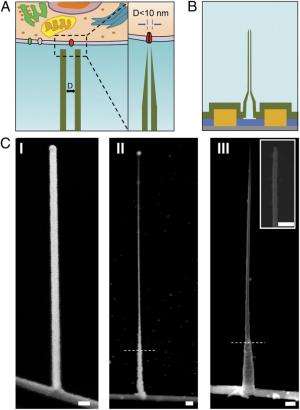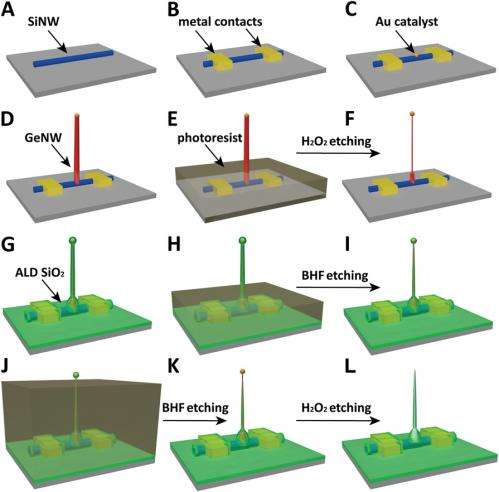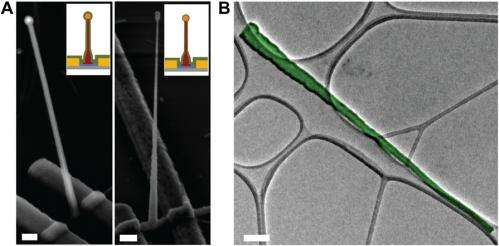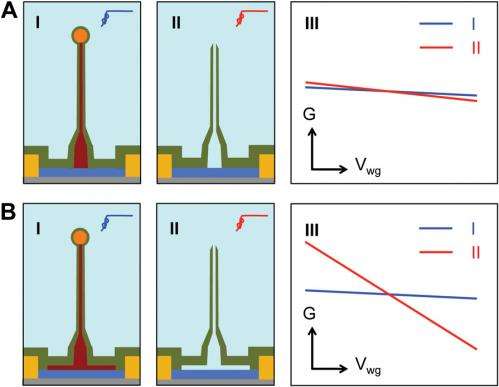February 3, 2014 feature
The twain finally meet: Nanowires and nanotubes combined to form intracellular bioelectronic probes

(Phys.org) —Miniaturized bioelectronic probes stand to transform biology and medicine by allowing measurement of intracellular components in vivo. Recently, scientists at Harvard University and Peking University designed, fabricated and demonstrated bioelectronic probes as small as 5 nanometers using a unique three-dimension nanowire-nanotube heterostructure. (A heterostructure combines multiple heterojunctions – interfaces between two layers or regions of dissimilar crystalline semiconductor – in a single device.) Through experimental measurements and numerical simulations, the researchers showed that these devices have sufficient time resolution to record the fastest electrical signals in neurons and other cells, with integration into larger chip arrays potentially providing ultra-high-resolution mapping of activity in neural networks and other biocellular systems.
Prof. Xiaojie Duan discussed the paper that she, Graduate Researcher Tian-Ming Fu, Prof. Charles M. Lieber and their co-authors published in Proceedings of the National Academy of Sciences. She first points out that nanotube probes and their heterojunction with silicon nanowire field-effect transistors (SiNW FETs) become mechanically less stable as diameter is reduced. "When the nanotube gets smaller and smaller," Duan tells Phys.org, "it gets easier to break the nanotube at the junction area with the SiNW. In the application of using the probe for intracellular bioelectronic detection, there will be various forces, such as the capillary force from the liquid, as well as interaction between the probe and the cell membrane. These forces may break the probe if we have a weak junction between it and the SiNW."
Another issue is that electrical sensitivity is also reduced as nanotube diameter decreases, because the nanotube inner diameter (ID) defines the effective device gate area. "In the recording of intracellular transmembrane potential using our probe," Duan explains, "cytosol fills the nanotube and acts as the gate electrode for the underlying SiNW FET." Cytosol (also termed intracellular fluid or cytoplasmic matrix) is the liquid found inside cells, excluding organelles and other cytoplasmic components. "The cytosol potential change modulates the carrier density of the SiNW FET, thereby changing its conductance," Duan continues. "This is how our probe works for bioelectronics recording." The contact area between the cytosol and the SiNW – defined by the inner diameter of the nanotube – determines conductance modulation effectiveness. In other words, if the nanotube inner diameter is too small, the SiNW FET gate area will be too small as well.

The researchers were also presented with the fact that high-frequency dynamic response may degrade with decreasing nanotube inner diameter due to increasing solution resistance in the nanotube. "When the nanotube inner diameter decreases," Duan explains, "the resistance of the solution inside the nanotube will increase, because of the decrease of the solution conductor cross-section." In addition, the speed at which the underlying SiNW FET can respond to a signal is determined by the product RC of the capacitance and the resistance of the solution conductor inside the nanotube – so if the nanotube is getting smaller, the resistance is getting bigger. This means that the SiNW FET will need more time to respond – and if the signal change is too fast, the probe will not be able to reliably record it. "That is what we mean by 'high-frequency dynamic response will degrade with decreasing nanotube inner diameter,' Duan adds, "However, we found that for our probe, even if we decrease the nanotube inner diameter to as small as 5 nm, the probe is still able to record a 3 kHz signal faithfully – a bandwidth sufficient in most cases for recording neural and cardiac signals."
The researchers were also confronted by the need to use active semiconductor nanowire field-effect transistor detectors to overcome the limitations of probe size reduction. "The word active' is compared to the 'passive' nature of recording with metal electrodes," Duan points out. "For metal electrode recording, a portion of the transmembrane potential Vm will be dropped or lost at the electrode/electrolyte interface, so the signal recorded will be smaller than the real transmembrane potential." When the size of the metal electrode is reduced, the impedance value at the electrode/electrolyte will increase – and at some point, this impedance will get so large that the recorded signal will be obscured by noise. However, for the FET recording, the cytosol potential change is reflected by the semiconductor channel conductance change, which is independent of the probe/electrolyte interface impedance. "Since decrease in probe size will therefore not affect the signal amplitude," Duan adds, "using the FET to sense potential is a very effective way to overcome the limitations of probe-size reduction."

Another critical challenge was synthetically integrating nanotubes and nanowires. "The nanotube is made of silicon oxide and the nanowire is made of silicon," Du an notes. "For cell recording, the nanotube needs to be built vertically onto the nanowires – meaning that a three-dimensional heterostructure is needed." While the heterostructure could be fabricated in various ways, not all of them provided the required controllability at the probe scale. Therefore, the researchers grew a germanium nanowire (GeNW) on top of the silicon nanowires, with the GeNW acting as a template for the nanotube. "Depositing SiO2 on the GeNW/SiNW heterostructure, then selectively removing the core GeNW, resulted in the desired nanotube/SiNW structure," notes Duan. "Using this method, the nanotube inner diameter can be controlled by the GeNW diameter, the outer diameter can be controlled by the SiO2 thickness, and the nanotube length can be defined by the GeNW growth time. This gives us complete and easily implemented control over the probe's dimensions."
Finally, the scientists had to investigate and model the bandwidth effect of phospholipid coatings, which are important for intracellular recording. "We use phospholipid coating to assist the nanotube probe to penetrate the cell membrane," Duan notes. "Since the bandwidth of our probe is important for the probe to be able to record fast neural or cardiac signal, we need to make sure this phospholipid modification will not overly affect the bandwidth." Because the phospholipid layer will decrease the cross section of the solution conductor inside the nanotube, it impacts bandwidth in two ways by changing the capacitance and resistance of the solution inside the nanotube. (The phospholipid-modified probe bandwidth is easily determined by applying a fast artificial signal to the solution, and then recording how the conductance of the device changes over time. This provides the time the device needs to respond to this signal and thus the device's bandwidth.) "Therefore," Duan explains, "if the nanotube is large, this thin phospholipid layer will not cause too much of a difference. However, for our probe, the sub-10 nm nanotube size is almost the same scale as the lipid layer – so we have to carefully examine how it affects probe bandwidth, both experimentally and theoretically."
The scientists addressed these myriad challenges in designing, fabricating, and demonstrating the probe with three key innovations. "The first is the use of FET as potential sensing element, which in principle enables us to overcome the size limit on the probe." Duan explains. "However, FETs have conventionally existed in a linear geometry with connections that preclude access to the inside of cells." The second innovation was the solution to this problem – namely, the design of a vertical SiO2 nanotube on top of the nanoscale FET, which allowed them to introduce cytosol into the cell without having to insert the FET channel inside the cell, which would be more invasive. The third key is the design of a relatively large nanotube base with a much sharper nanotube tip, resulting in a sub-10 nm probe without sacrificing its mechanical strength and electrical sensitivity.

An important aspect of the study was ensuring that the bioelectronic devices had sufficient time resolution to record the fastest electrical signals in neurons and other cells. "The signals in neural system are normally in the millisecond scale," Duan points out. "That means that to reliably record these signals, the recording device needs to have a bandwidth measure in kilohertz." While the probe's bandwidth decreases with the decrease of nanotube diameter, the scientists found that even for probes with inner diameters as small as 5 nm, the bandwidth is still around 3 kHz (a time resolution ~ 0.3 ms) in physiological solution. "This means that our probes have sufficient time resolution to record the fastest electrical signals in neurons and other cells," Duan adds.
Moreover, Duan points out, the scientists found that measuring the cell transmembrane resting potential with these ultrasmall bioelectronic devices demonstrates the capability for intracellular electrophysiology studies. "When we measured the transmembrane resting potential of HL-1 cell with our new probes, we found that with the phospholipid modification, the nanotube can easily and reliably penetrate the cell membrane, allowing the FET to record the intracellular transmembrane potential at full amplitude." After retracting the nanotube from the cell, the recorded potential can immediately revert to the extracellular potential. "Reliable cell membrane penetration and stable recording of intracellular transmembrane potential prove the capability of our probes for intracellular electrophysiology studies," notes Duan.

Moving forward, says Duan, the researchers' are planning to scale up their work to integrate the probes into high-density, large-scale array for large-scale mapping of neural activities; use the probes to record neural signals from small subcellular structures/organelles; and investigate other applications in which the probes will provide substantially greater spatial resolution and minimal invasiveness than other techniques.
In addition, the scientists might consider developing other innovations. "For example," Duan illustrates, "a major challenge in using our ultra-small probes for recording from small subcellular structures is to accurately position them with respect to the subcellular structures of interest. We're looking at either labeling our probe with fluorescence dye – or other biocompatible materials – to mark the nanotube at high resolution, or using specific targeting in which the probe's biochemical surface groups define the specific cell location being studied."
Duan sees other areas of research that might benefit from their study, including:
- Neuroscience: Since recording of intracellular action potential and other low frequency transmembrane potential signal is important to study the neural network.
- Medicine: By studying how the drugs affect the recorded intracellular action potentials or other transmembrane potentials, the probes can provide an attractive technique for parallel or high-throughput screening of drugs targeting the ion channels.
- Biophysics: The process of cell membrane penetration by the phospholipid-modified nanotube can serve as a useful platform for studying the cell membrane's fusion-related biological processes.
More information: Sub-10-nm intracellular bioelectronic probes from nanowire–nanotube heterostructures, Proceedings of the National Academy of Sciences Published online before print on January 13, 2014, doi:10.1073/pnas.1323389111
Journal information: Proceedings of the National Academy of Sciences
© 2014 Phys.org. All rights reserved.


















